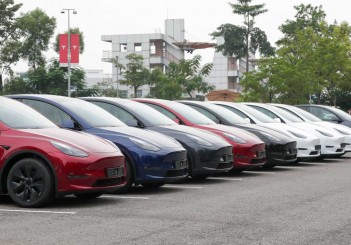This is the GT-R(X) 2050, created by Jaebum "JB" Choi, a design student and intern at Nissan Design America (NDA) in La Jolla, California.
The completed 1:1 project runs just under 3 metres long and sits just over 60cm high.
The driver wears a futuristic, form-fitting suit and helmet that resembles a superbike riders’ protective helmets and leathers.

Choi’s futuristic project takes cues from the current Nissan GT-R – namely its bold, dramatic surfaces, monolithic body volumes and V-motion design features. It also has iconic GT-R taillights and red-striped accents of the GT-R NISMO.
Another unique element is the GT-R styled helmet and "docking" suit. The helmet was designed to be inserted into a slot for front vision camera shared with VR vision. A brain-to-core transmitter would help the human brain activate digitalised signals.
As a vehicle that would be "driven", most likely at night, maneuverability would be a critical part of its high-power electric performance.

Choi imagines the vehicle’s one-piece wheel/tyre units as having a shape close to square, allowing the vehicle to turn 360 degrees. The outer tyre diameter measures 21 inches and inner wheel circle is 15 inches. The wheels’ spoke pattern was designed to help the wheel cool down fast, even under extreme braking.
The GT-R(X) 2050 also deploys an active wing that would add downforce when extended. The wings fold so the driver can get in and out of the car.
As a "wearable machine," Choi envisions that connecting the human brain to the computer’s would provide better performance than "ordinary" self-driving cars. He says the vehicle imitates the shape of the human body so it can efficiently protect the brain.

"Exo-skeletons today make people stronger by wearing mechanical structures. I tried to fit the size of a person’s body as much as I could, as if I were wearing a car," Choi explains about the vehicle’s compact layout.
"I wanted to create a new form of machine that is not a vehicle to ride, it is the space where machine and the human become one."













